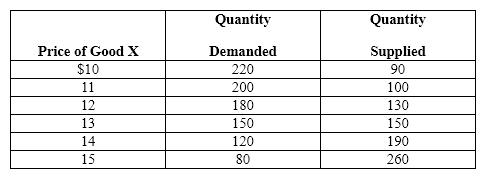Multiple Choice
Exhibit 4-9  Refer to Exhibit 4-9. Suppose that the government imposes a price ceiling at a price of $10. The number of units that would be exchanged in this market would be
Refer to Exhibit 4-9. Suppose that the government imposes a price ceiling at a price of $10. The number of units that would be exchanged in this market would be
A) 150, since that is the equilibrium quantity and the price ceiling is below the equilibrium price.
B) 220, since that is the number of units demanded at the price ceiling (and the quantity demanded is greater than the quantity supplied) .
C) 90, since that is the number of units supplied at the price ceiling (and the quantity supplied is less than the quantity demanded) .
D) 155, since that is the average of the quantity demanded and the quantity supplied at the price ceiling.
Correct Answer:

Verified
Correct Answer:
Verified
Q64: A tax placed on a good can
Q72: If the absolute price of a new
Q74: Buyers always prefer lower prices to higher
Q106: A shortage of kidneys (for transplants)results from<br>A)the
Q107: Exhibit 4-7 <img src="https://d2lvgg3v3hfg70.cloudfront.net/TBX9059/.jpg" alt="Exhibit 4-7
Q110: Exhibit 4-11 <img src="https://d2lvgg3v3hfg70.cloudfront.net/TBX9059/.jpg" alt="Exhibit 4-11
Q112: One of the effects of a price
Q113: Exhibit 4-7 <img src="https://d2lvgg3v3hfg70.cloudfront.net/TBX9059/.jpg" alt="Exhibit 4-7
Q115: Suppose that the government sets a price
Q116: Exhibit 4-8 <img src="https://d2lvgg3v3hfg70.cloudfront.net/TBX9059/.jpg" alt="Exhibit 4-8